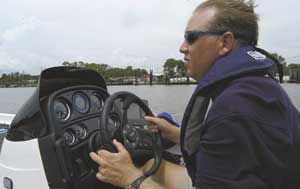
This Northwest Louisiana lake frequently lives up to its name.
Last month I wrote about steering systems becoming stiff, and how to repair them when this happens.Almost immediately, I was contacted by several readers who needed to replace their steering systems. They wanted to know what type of steering system they should install on their boats. I explained that there are several brands and types of steering available. Each boat and engine package needs to be evaluated to choose the best steering for it.
Back in the old days, steering was fairly simple. It consisted of a round drum mounted under the dashboard with a cable wound around that drum. The cable was routed to the side of the boat, then to the transom and eventually the engine via a series of pulleys.
This system got the job done, but there was so much play in the cables and pulleys that often the cable would become dislodged from the drum and the engine would flop from side to side wildly. Many times this would result in someone getting hurt.
I don’t remember exactly when, but around 1960 mechanical steering was introduced to the marine industry. This single cable, push-pull system virtually eliminated the danger of a steering system that becomes disconnected, allowing the boat and engine to run out of control.
Steering system manufacturers now offer many different steering systems that can fit virtually any type of boat and engine imaginable. Selecting the most appropriate system for your boat is critical.
Engine horsepower and boat speed are two important factors that must be considered when choosing a steering system. Boats that are capable of speeds in excess of 50 m.p.h. may develop instability problems that will need to be considered when choosing a steering system. Large offshore boats with two or more engines may require a more powerful steering system in order to muscle those large engines from side to side.
Generally it is a good idea to replace your boat’s steering system with the same type that was originally installed on the boat. In other words, replace rotary steering with another rotary, rack-and-pinion with another rack-and-pinion or hydraulic with a similar hydraulic.
The rotary and rack-and-pinion systems are mechanical cable steering. They are offered in single- and dual-cable versions. Most single-cable systems are recommended for use on engines up to the V4 size, provided the boat and engine package will not exceed 50 m.p.h.
If your boat is capable of speeds in excess of 50 m.p.h. or if you have an engine larger than a V4, you should be using either a dual-cable or hydraulic steering system. You should consult your steering manufacturer for his exact recommendations before installing a system on your boat.
Steering systems are also rated by the number of turns it takes to go from lock-to-lock with the steering wheel. The higher the number, the easier it will be to turn the wheel but the boat will be slightly less responsive when maneuvering.
In other words, a steering system rated as three turns lock-to-lock will be very responsive but will take more effort to turn. This system would work well on a smaller boat with less horsepower. A larger boat will need more power at the wheel, so a system that is rated as 4.2 turns lock-to-lock would be better for this boat.
Several years ago, Teleflex Marine introduced a revolutionary new steering system they call No Feed Back (NFB). The NFB system was designed to eliminate steering load or torque. When your engine is running, the rotation of the propeller creates a turning energy that, in effect, is pushing the engine to the side opposite the rotation of the prop. This steering load will cause the engine to turn to that side if you let go of the wheel.
Teleflex’s NFB system incorporates a clutch within the helm assembly that virtually eliminates steering load.
If you should accidentally let go of the steering wheel, the boat will remain on course. Steering load will not be allowed to force the engine into a hard turn, and you and your passengers will be safe. If your boat is currently equipped with single- or dual-cable, rotary or rack-and-pinion steering, I would strongly advise you to consider using NFB.
For those of you who have large offshore boats, high-performance boats or boats equipped with multiple engines, hydraulic steering may be for you. Hydraulic offers the advantages of NFB steering, and is more powerful than the mechanical systems. It can handle much larger horsepower engine packages on even larger boats, and it offers excellent stability control on the high-performance boats as well.
Steering systems are a vital part of your boat’s performance and safety. When you are ready to change the steering system in your boat, consult with your local dealer for his recommendations. Check out all of the options, and try to match the steering system with your boating needs. Some steering systems may have an attractive price tag, but remember when you shop price, you usually get what you pay for.
If you have any questions about your boat, motor or trailer, you can e-mail me at hanktheboatdr@yahoo.com.


